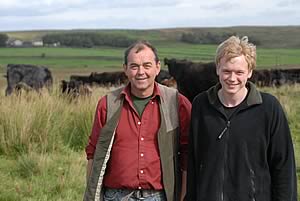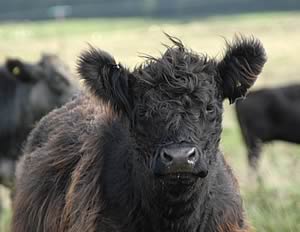| |
|
04/11/08
Easily managed Galloways are proving to be the ideal low-input cow alongside traditional Swaledale ewes for an upland farm in Northumberland with important implications for the environment.
Tom Robinson, left, with son Philip and Galloway cows and calves on the white hill at Ottercops.
 |
Tom Robinson and his son Philip farm 2,730 tenanted acres at Ottercops, Kirkwhelpington, near Morpeth, 2,000 acres of which are heather rising to 1,000 ft above sea level.
The whole of the Less Favoured Area farm is in Countryside Stewardship with the 70 acres of grass classed as flower meadows and there are 31 protected sites ranging from Bronze Age burial sites to a World War II radar station.
The Robinsons are hoping that the Galloways, favoured by environmentalists for their non-selective grazing of rough land, will help them in their bid to enter Higher Level Stewardship.
Ottercops is farmed on organic lines. Until January 2008, the farm was run under organic stewardship, however, new requirements to feed livestock with 100 per cent organic feed and rising feed costs led the Robinsons to leave the scheme although still maintaining a low-input system with no artificial fertiliser used.
Tom Robinson says the Galloways cost virtually nothing to keep. Under the Stewardship agreement, the Robinsons are paid to cut the upland flower meadows and this poorer quality grass is made into silage which is perfect for the Galloway cows to eat over the winter months whereas other types of cattle would not do so well on it.
Again, the farm’s flock of 1,500 Swaledale ewes, 600 of which are bred pure to provide flock replacements and the remainder are crossed with the Bluefaced Leicester to produce Mule lambs, are run on a very low-input, simple system with little supplementary feeding.
The Robinsons took on the tenancy of the farm in 1999 and after foot and mouth two years later, having no suckler cow quota, Tom began to buy in competitively priced Galloway bullocks at about seven months old, selling them on for finishing after taking the first and second premiums.
“We found we could sell the bullocks easily through Longtown Mart as there was quite a niche market for them,” said Tom.
“We would buy the bullocks at about seven months old and sell them as strong stores at 22 months old at favourable prices. We would keep them for two winters and a summer on the better land but not feed them any concentrates,” he added.
Over this time the price to buy in the bullocks almost doubled as the breed became more popular and Tom thought it was time to invest in his own cows.
The herd’s first females were bought at Hexham Mart in 2004 – 20 pure but unregistered females and calves from the dispersal of the herd run by Messrs Robson at Birtley near Hexham. These included in-calf heifers, bulling heifers and heifer stirks.
Galloway cow at Ottercops
 |
“We still have 16 of the original females. They were quiet and they produced tremendous thick-set bullock calves. They have milked well and they stayed fit,” said Tom.
Herd numbers were further increased with the purchase of 14 bulling heifers from Arran and a number bought in Carlisle and privately.
Originally, they were all crossed with the Whitebred Shorthorn bull. A Galloway bull was bought for the first time at the Carlisle spring sale in 2008 – Bruno of Haining House which was rising three years old – with the intention of breeding herd replacements.
All the Galloways are now either registered pedigree or are in the society’s appendix register. In the spring of 2009, 77 are due to calve, with 10 put to the pure Galloway for replacements.
The Robinsons also have their own small herd of Whitebred Shorthorns to breed stock bulls. They bought their first in 2006 – an in-calf Barlaes heifer from Gordon Jackson at Blackburn and two bulling heifers from Keith Laurie, of Snowdon Close, Gilsland.
The bull East Deloraine Yahoo, now seven years old, was bought from the Davidsons of East Deloraine, Selkirk for the first batch of Galloway cows and in 2006 another Whitebred bull, Barlaes Choir Boy was bought at Carlisle.
The Whitebred herd is being kept small and only numbers three cows and a heifer calf as well as an 18 month old bull and two bull calves.
To meet stewardship requirements, the Galloway cows that are out on the white hill are kept in five batches of up to 16 cows and each needs a bull to run with them.
The herd is all spring calving starting on March 1. To prevent poaching of the ground, all the cows are housed from November 25 until well into May as the farm has a late spring. Again, to preserve the ground, no supplementary feed is given outside.
After calving, they are turned out on the hill at around May 20 to graze the white ground.
Blue-Grey calves are sold in October and November straight off their mothers through Newcastleton mart.
Of the first Galloway calves born in the spring of 2009, heifers will be kept as replacements and the bullocks will be sold at six months old along with the Blue Greys at Newcastleton in the autumn.
“The Galloways are very easily managed by Philip, who really is the cow man, and myself – we have some casual labour on the farm and silaging and muck spreading are done by contractors,” said Tom.
“We calved nearly 30 heifers in a year and we assisted five calvings but didn’t need to call in the vet.

“Our vet’s bills are very low. We have only called the vet out once to a cow with listeria and as far as medicines go we only use a lice treatment during the winter. Because we are selling the calves straight off their mothers we don’t worm them. They are very economical to keep with only the cows getting silage in the winter.
“The market has been surprisingly good for the Blue Grey calves as I think there is more interest in the eating quality of traditional breeds and as a result, more feeders are buying these calves which they can finish without concentrate feed.
The Galloways also have the advantage of thriving even on poorer quality forage crops when there has been a bad summer for getting silage.
In the autumn of 2007 the bullocks were making around £300 a head off their mothers and with improved prices for beef, this year they are expected to make up to another £70 a head.
The ewes at Ottercops are lambed outside in May and, with the exception of those with twins which get a small amount of feed, they are out on the heather and rush hill all summer.
All the gimmer lambs are sold direct from the holding, this year to one farm in the south west of England.
Swaledale and Mule wether lambs are sold store straight off their mothers.
 Carhall Holstein Stars Must Milk for a Living Carhall Holstein Stars Must Milk for a Living
 Faithful to the Bleu du Maine Faithful to the Bleu du Maine
 Adding Value to Jersey Milk Adding Value to Jersey Milk
|






